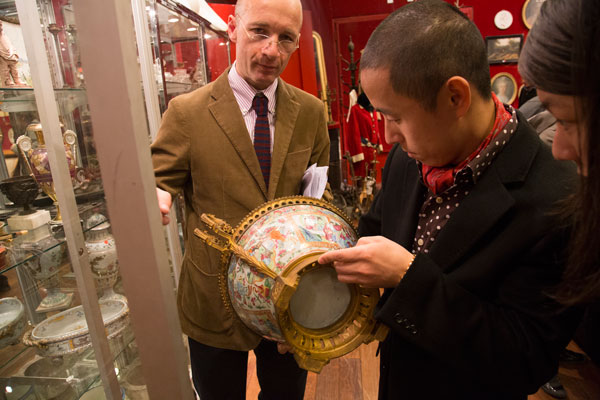In France alone, the total sales of Asian art exceeded 200 million euros last year, accounting for 24 percent of the sales in the French art market, according to figures provided by Conseil des Ventes, the French auction regulatory authority.
Chinese art pieces have also become the top sellers at major auctions in Europe because of their ability to fetch jaw-dropping prices. In 2011, an 18th century Chinese silk scroll painting from the Qianlong period of the Qing Dynasty (1644-1911) was sold to an unnamed Chinese bidder for $31 million, which set the record for Chinese art at French auction houses.
An imperial album known as Zhigongtu in Chinese from the same period fetched $10.6 million last year in France and was bought by an unnamed Chinese collector.
"Sometimes it can be difficult for us to fully understand the size of the country and the potential of the Chinese buyers. It is simply beyond imagination. The prices at the auctions are often exceptional," Bresset from Artcurial says.
Leila de Vos, the European head of Chinese works of art at London-based global auction house Christie's, says that Chinese spending has grown more than 250 percent in the past five years.
"The more people are active in our sales, wherever they are from, the more competition there is for each lot. And this in turn leads to the lots going for higher prices," she says.
 |
|
A Chinese examines a porcelain vase at one of the oldest French auction houses, Drouot. Li Xiang / China Daily
|
Bubble issues
The sharp rise in prices of Chinese art, both at home and in international art markets, driven by deep-pocketed Chinese buyers, has prompted several experts to link it to the Japanese-driven impressionist art bubble of the late 1980s.
Dutch painter Vincent Van Gogh's artwork Sunflowers was bought by a Japanese institution in 1987 at a record price of $39 million, which also signaled the height of Japanese economic power. Bubble fears were stoked and proved right later after impressionist art prices collapsed when the Japanese economy tanked. Experts feel that the buying frenzy unleashed by Chinese investors could trigger potential bubbles in the European art market.
"Many of my Chinese clients were those who used to buy artworks for 1,000 or 2,000 euros at the flea markets," says Philippe Delalande, a leading global expert on Asian art. "These same clients are now bidding for major artworks at big auction houses. It is a pretty amazing progression."
"It has become a game for them. The competition is becoming really high. Sometimes the price goes to a level that is quite dangerous."
William Chak, a well-known art dealer from Hong Kong who set a world record in 2005 by paying HK$115.4 million ($14.9 million) for an 18th-century porcelain vase from the Qing Dynasty, also has similar concerns.
"When I first came to Europe in the 1970s, looking for valuable pieces was a joyful experience. But now it has become a burden because the catalogues of auction houses are getting thicker and thicker and people are buying art pieces like shopping in the supermarkets," Chak says.
"What is worse is that the art market now seems very unhealthy in that it is full of people who consider art collection as a lucky dip and a quick way to make money."
We recommend:
